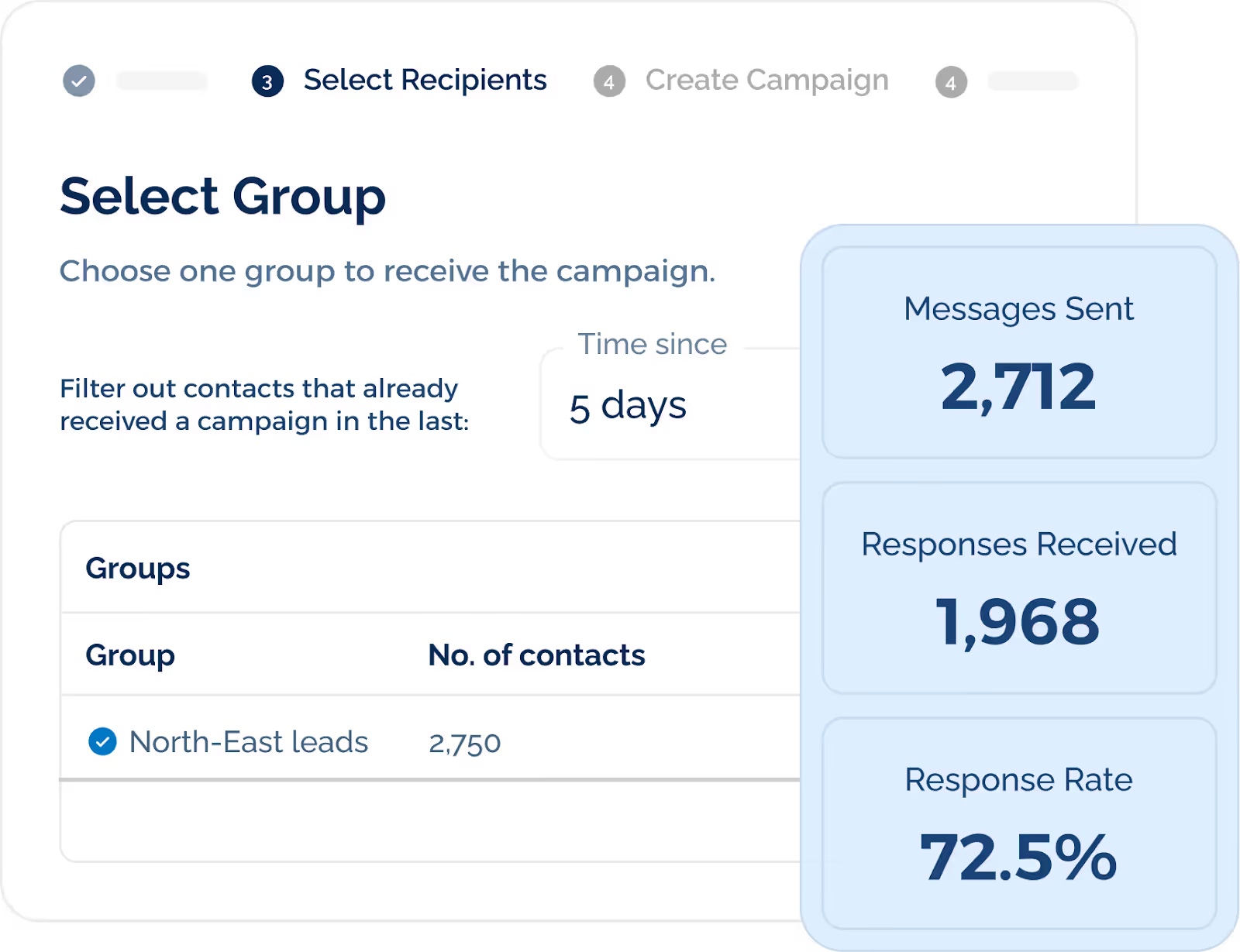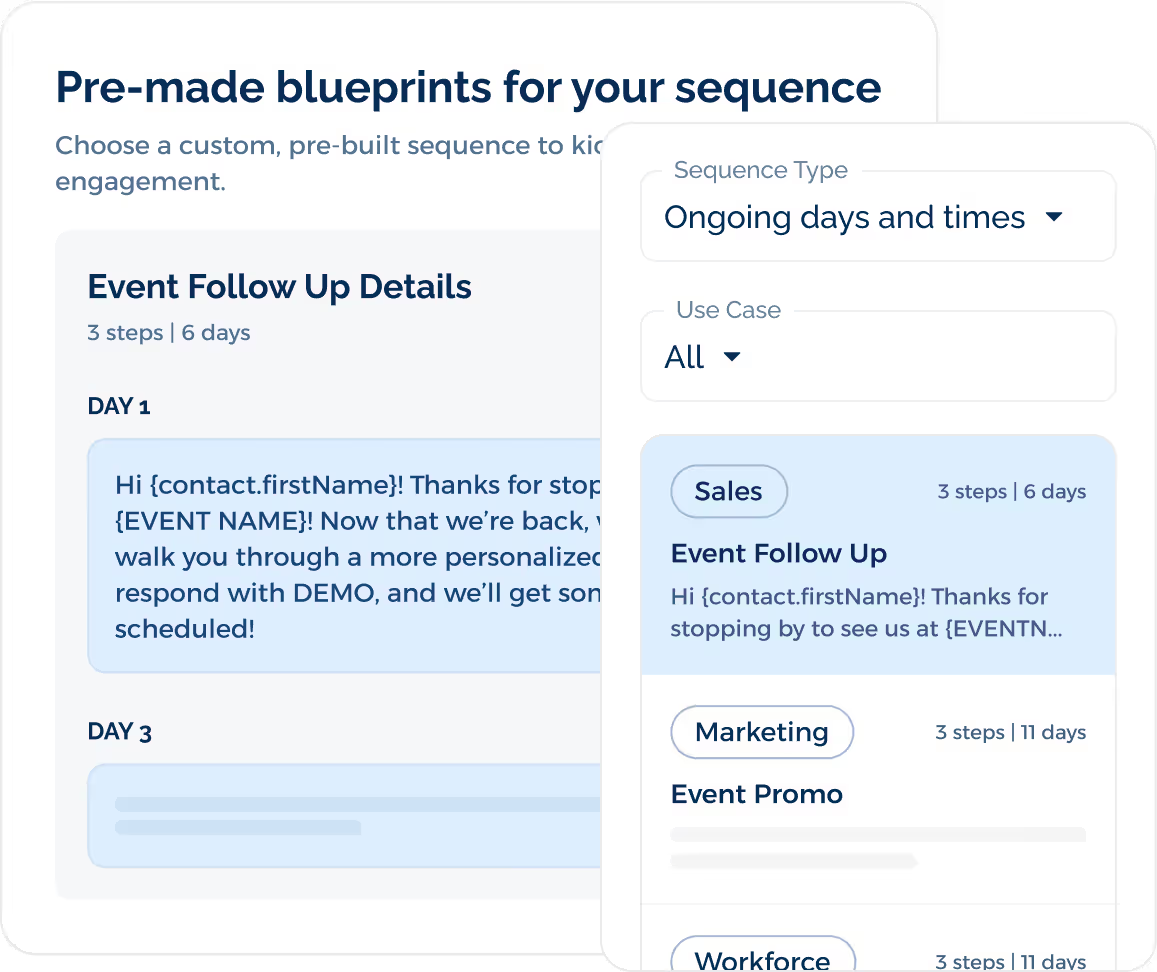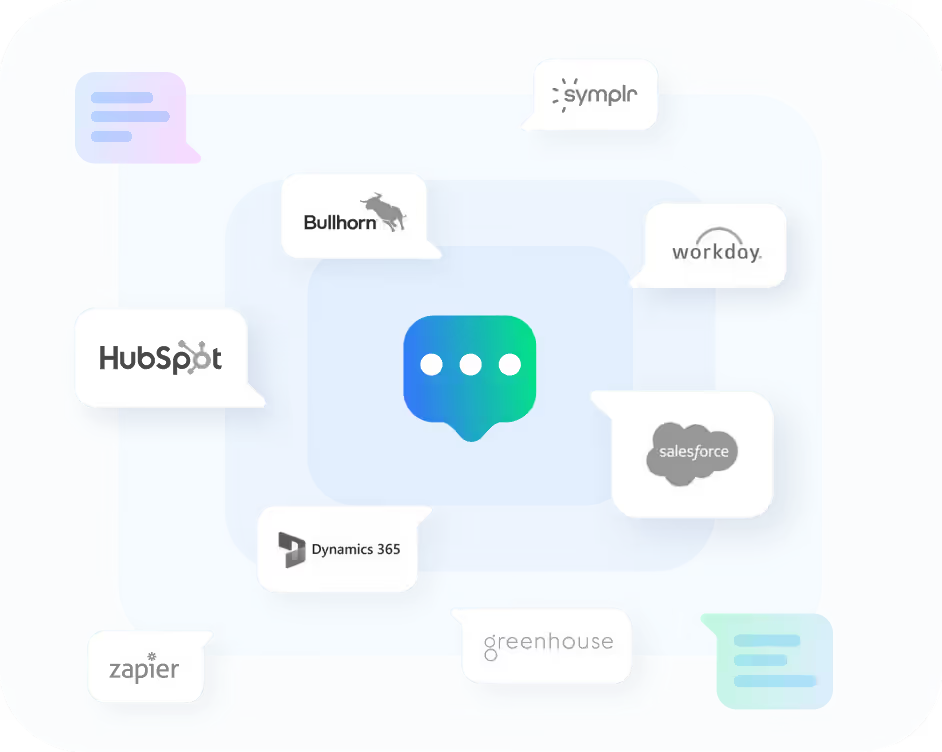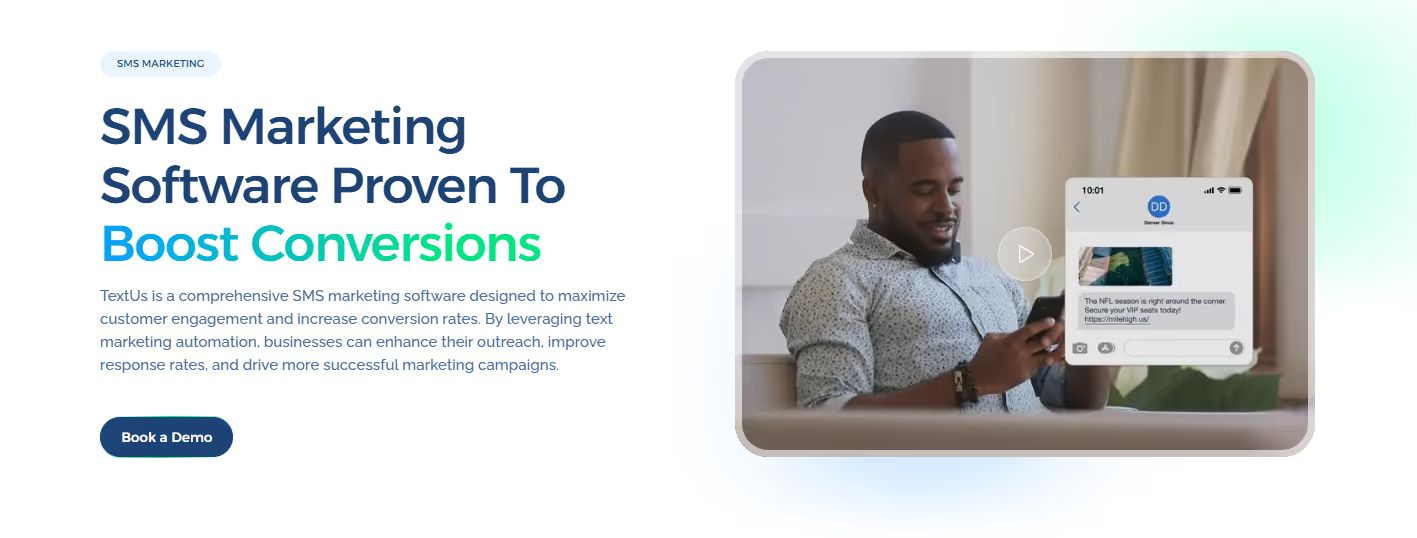15 Creative Text Message Marketing Examples You Can Use
Explore 15 creative text message marketing examples you can use and see how TextUs can help you build campaigns that convert.
Published
October 7, 2025

With most texts being opened within minutes, it’s no surprise that businesses are turning to SMS as a key part of their marketing strategy.
The opportunity is huge, but how do you craft messages that not only get read but also spark action? A simple text can reach, but a strategic text can drive action.
In this article, we will explore some of the best SMS marketing examples you can apply to your own business. You’ll learn how different types of campaigns work, what makes them successful, and how you can use SMS to build stronger connections with your audience.
Why Text Message Marketing Works
SMS marketing is one of the most effective ways to reach customers because of its direct nature. Unlike emails that can get buried in inboxes or social media posts that compete with endless scrolling, texts almost always get noticed.

In fact, SMS open rates average around 98%, while email marketing typically hovers between 20% and 30%. That alone makes it a powerful channel if you're looking for visibility.
Another reason SMS stands out is the speed of response. Studies show 95% of texts are read within just 3 minutes of being received. This immediacy means that time-sensitive messages have a much higher chance of driving action compared to other marketing channels.
Beyond the numbers, texting is more effective because it feels personal. A well-crafted SMS comes straight to a customer’s phone and sounds like a direct conversation rather than a broadcast.
Personal touch builds trust and makes customers more receptive to messages, especially when you respect preferences by keeping texts relevant and not overloading your audience.
Finally, SMS offers versatility that you can use to your business advantage. From promotional campaigns to service updates and surveys, it can support customer acquisition and retention.
Paired with an SMS engagement platform, you can automate follow-ups, segment audiences for targeted campaigns, and sync conversations into your CRM. The combination of speed and personalization is why SMS continues to deliver strong value across industries.
15 Examples of Text Message Marketing Campaigns
SMS is flexible, and you can shape it around your specific business goals, such as boosting sales or improving the overall customer experience. Below are a few SMS marketing campaigns you can run to connect with your audience better.
1. Opt-In SMS Campaigns
Opt-in campaigns are the first step in SMS marketing. They confirm a customer’s consent to receive SMS messages, which is legally required under TCPA (Telephone Consumer Protection Act). They also set expectations about message frequency and purpose.
Examples
- “Reply Y to confirm your subscription to Trendy Styles. Expect 4–6 msgs/month. STOP to cancel anytime.”
- “Thanks for signing up! Reply YES to start receiving exclusive text-only deals.”
- “Confirm your subscription by replying Y. You’ll get discounts, updates, & VIP access.”
2. Welcome SMS Campaigns
Welcome messages greet new subscribers, set expectations, and deliver a special offer. This first impression creates excitement and makes engaged customers more likely to act right away.
Examples
- “Welcome to Fresh Foods! Enjoy 15% off your first order with code WELCOME15.”
- “Thanks for joining our VIP list! Free shipping on your first order with code HELLO.”
- “We’re glad you’re here! Use code NEW20 for 20% off your first purchase.”
3. Promotional SMS Campaigns
Promotional messages highlight discounts, sales, and limited-time deals. Including a direct link in your message makes it easy for people to click and buy instantly.
Examples
- “Save 25% on your next order! Use code SAVE25 at checkout today. [link]”
- “Exclusive offer: Free shipping on orders $50+. Shop now!”
- “It’s BOGO day! Buy one, get one free on select items. Shop today: [link]”
4. Flash Sale SMS Campaigns
This is a subtype of promotions with an extremely short time window. These texts create a sense of urgency and drive immediate conversions, moving excess inventory fast.
Examples
- “FLASH SALE! 50% off all sneakers—ends in 4 hours! Shop: [link]”
- “Hurry! 30% off sitewide until midnight. Don’t miss out: [link]”
- “Final hours! Extra 20% off clearance items. Ends at 11:59 PM: [link]”
5. Abandoned Cart SMS Campaigns
These campaigns are triggered when a customer leaves items in their cart without purchasing. Sending timely abandoned cart reminders can recover lost revenue.
Examples
- “Forgot something? Complete your order now & enjoy 10% off with code CART10.”
- “Your items are waiting! Checkout now for free shipping: [link]”
- “Hey Sarah, still thinking about those jeans? Grab them now—they’re almost gone! [link]”
6. Transactional SMS Campaigns
Transactional texts related to a customer’s action, like confirming an order, payment, or subscription. Always include the right contact details so customers know where to follow up if needed.
Examples
- “Order #8234 confirmed. Expect delivery by Thursday. Track: [link]”
- “Payment received—thank you! Your invoice has been emailed.”
- “Subscription renewed! Next billing date: Nov 15.”
7. Shipping & Delivery Updates
This is a transactional subtype focused only on shipping and delivery notifications. It keeps customers engaged and improves overall satisfaction.
Examples
- “Your package is out for delivery. Expect arrival today 2–5 PM.”
- “Great news! Your order has been delivered. Enjoy your new items.”
- “We’re packing your order now. You’ll receive tracking info shortly.”
8. Appointment Reminders
Automated messages are used for reminding customers before a scheduled appointment or service. They reduce costly no-shows and make rescheduling easy for customers.
Examples
- “Reminder: Your haircut with Lisa is tomorrow at 2 PM. Reply C to confirm.”
- “Hi Alex, your dentist appointment is on Monday at 10 AM. Reply R to reschedule.”
- “Don’t forget! Your personal training session is today at 6 PM.”
9. Event Reminders
These are used to promote and remind about webinars, classes, or in-person events. A brand-announced event via SMS feels more direct and immediate than an email alone.
Examples
- “Your webinar ‘Marketing Trends 2025’ starts in 1 hour. Join: [link]”
- “Reminder: Grand Opening tomorrow at 11 AM! Show this text for 10% off.”
- “Our free class starts tonight at 7 PM—don’t miss it! RSVP: [link]”
10. Personalized SMS Campaigns
These campaigns tailor offers to user-generated content, purchase history, or customer milestones. They make texts feel highly relevant.
Examples
- “Happy Birthday, Mike! Celebrate with 20% off. Use code BDAY20.”
- “We noticed you love skincare. Here’s 15% off our new moisturizer: [link]”
- “Thanks for being a loyal customer, Sarah! Your next order ships free.”
11. Product Launch Campaigns
These campaigns let you announce new arrivals or product lines. It builds hype, offers early access, and drives adoption or sales.
Examples
- “Just dropped: NEW EcoBottle. Grab yours today: [link]”
- “Sneak peek: Our new collection is here! Shop early access: [link]”
- “Introducing our latest flavor—try it today with 10% off.”
12. Seasonal Campaigns
These personalized messages are tied to holidays or seasonal shopping periods.
Examples
- “Black Friday Deal! 40% off storewide today only: [link]”
- “Happy Holidays! Enjoy free shipping all week with code MERRY.”
- “Summer Sale: Get 30% off swimsuits. Ends Sunday: [link]”
13. Loyalty & Rewards Campaigns
These campaigns engage repeat customers with rewards, points updates, or perks. They encourage retention and grow your SMS list of long-term buyers.
Examples
- “You’ve earned 500 points! Redeem today for $10 off.”
- “VIP Reward: Free gift with your next order. Show this text at checkout.”
- “Your points expire soon! Redeem before Oct 15: [link]”
14. Lead Nurturing Campaigns
Drip campaigns use automated text message sequences to move prospects toward purchase. They keep leads warm and reduce drop-off in your funnel.
Examples
- “Hi [Name], ready to see how our platform works? Schedule your demo: [link]”
- “Still considering? Here’s how we helped businesses like yours save 25%. [link]”
- “Reply YES to connect with our marketing teams today.”
15. Feedback & Survey Campaigns
These are quick polls or surveys sent after purchases or visits. It helps you improve service while showing customers you value their opinion.
Examples
- “How did we do? Reply 1–5 (5 = Excellent).”
- “Thanks for your visit! Take this 1-minute survey: [link]”
- “Would you recommend us to a friend? Reply YES or NO.”
Best Practices for Text Message Marketing Campaigns
If you want your SMS marketing strategy to get results, there are a few rules you should follow. These are the practices that will keep your SMS subscribers engaged and your business compliant.
Get Permission First
The first rule of text message marketing is one you can’t afford to skip: always get your customer’s permission before you send them anything. Texting is personal, and when someone agrees to hear from you, they’re giving you access to a private space.
Regulations like TCPA in the United States require an opt-in message before you can send texts. If you ignore this, you risk fines and, even worse, damaging your reputation.
Opt-ins make your campaigns stronger. When people choose to sign up for your texts, they’ve already shown interest in your business. That means your audience is warmer, more engaged, and far more likely to respond to your offers.
You can use sign-up forms on your website, at checkout, or in person at your store. Let people know how often they can expect messages and what kind of content you’ll send, like discounts, reminders, or updates.
Keep Messages Short and Clear
One of the biggest mistakes businesses make with text marketing is overloading their audience with too many messages. Texts are meant to be quick and to the point.
A good rule of thumb is to keep your message easy to scan and understand in just a few seconds. Focus on a single idea and one specific action for your target audience.
For example, instead of sending a long, wordy message about a weekend sale, you can say, “Weekend Sale: 30% off all shoes. Shop now: [link].” Including your business name at the start of the message also helps customers instantly recognize who it’s from.
Remember to use simple language, avoid jargon, and highlight the value right away. Text subscribers should know instantly what’s in it for them.
Personalize Whenever Possible
Customers don’t want to feel like they’re just another number on your list. Personalization is what turns a standard text into something that feels like a one-on-one conversation.
It can be as simple as including someone’s first name. That tiny detail makes the interaction warmer and more human. You can also go deeper by tailoring offers to customer preferences.
For example: “Hi Mark, thanks for buying running shoes last month. Here’s a discount code for 20% off athletic socks to go with them.” A message like this doesn’t just show you know your customers, but also increases the chance of a next purchase.
Another smart move is using behavioral data to personalize timing. If you notice certain customers tend to open messages in the evening, schedule your texts to land in that window.
The message itself doesn’t change, but the delivery feels much more thoughtful when it matches customer habits.
An SMS marketing software like TextUs helps you make personalization manageable. You can segment your audience into groups, like loyal customers, first-time buyers, or people who haven’t purchased in months.

Then, create different messages for each or automate birthday texts or loyalty rewards. This way, every customer gets a message that feels like it was written for them.
Conversational SMS marketing also doesn’t stop once you hit send. Customers reply with questions, requests, or purchase decisions, and how quickly you respond can make or break the outcome.
With TextUs shared inboxes, your team can collaborate in real time, stay aligned on ongoing conversations, and maintain a consistent voice with every customer.
Send Messages at the Right Time
Timing is everything in SMS advertising. You might have the perfect offer, but if you send it at the wrong time, it could get ignored or even irritate your loyal customer.
The goal is to send messages when your target audience is most likely to be receptive. For most businesses, mid-morning to early evening works best. But your ideal time depends on your industry.

A restaurant might do better sending time-sensitive lunch specials at 10:30 a.m., while an online store may get higher engagement in the evening.
Consistency also matters. If your customers know they can expect your updates on certain days or at predictable times, your messages feel less random and more like part of a relationship.
Focus on Providing Value
Every text you send should answer one question: why should my customer care about this? Providing real value is the foundation of SMS marketing success.
Value can come in many forms. A gift or coupon drives sales. Appointment reminders save people time. Exclusive previews make customers feel like the most loyal customers. Even a quick thank-you note after a customer's purchase makes someone feel appreciated.
When you focus on value, your texts stop looking like spam and start feeling like helpful nudges. This is what keeps your loyal SMS subscribers happy and looking forward to the next message.
Be Mindful of Frequency
Even if your texts are valuable, there’s a limit to how often you should send them. If your brand sends abandoned cart messages or promotions too frequently, people will use opt-out options quickly.
For most businesses, two to six per month is a good starting point. A retailer running frequent sales might send cart reminders, while a dentist may only need to send appointment confirmations.
The important part is matching message cadence to customer preferences so that your brand voice feels consistent rather than overwhelming.
It also helps to be upfront about frequency from the very beginning. When someone opts in, tell them how many texts they can expect each month. If you say “no more than four messages per month” and keep that promise, you’ll strengthen trust and improve your overall marketing efforts.
Make Opt-Outs Simple
No one likes losing subscribers, but making it easy for people to opt out is one of the most important parts of running a successful marketing program.
When customers feel trapped in your list with no way out, they don’t just get frustrated with the texts but also lose trust in your brand altogether.
The best practice is to include simple instructions in every campaign. A short SMS example like “Reply STOP to unsubscribe” works perfectly. Making it effortless shows confidence in your value and proves you respect the relationship.
TextUs helps you automate this process. When someone replies with “STOP,” they’re automatically removed from your active list. It keeps you compliant and saves you from the headache of manually updating contacts.
Stay Compliant With 10DLC Rules
10DLC stands for “10-digit long code,” which is the system carriers now require businesses to use when sending text messages from standard phone numbers. It was designed to cut down on spam and protect customers from receiving unwanted texts.
What this means for you is that your business needs to register its texting campaigns with carriers before you start sending at scale. Without registration, your messages could get filtered, blocked, or delayed, even if you’re doing everything else right.
Worse, you could risk fines or have your number flagged. Registering properly ensures your texts get delivered reliably and that you maintain a professional reputation with your customers.
The good news is you don’t have to handle this process alone. An SMS engagement platform like TextUs makes 10DLC compliance simple. They walk you through the steps, manage the paperwork, and ensure your campaigns are fully compliant from day one.

That way, you can focus on writing great campaigns and building customer relationships instead of worrying about technical requirements.
Integrate SMS With Other Channels
Text message marketing is powerful on its own, but it becomes even stronger when you combine it with your other communication channels. When you integrate these channels, your customers get a smoother, more consistent experience with your brand.
You might announce the sale on social media to build awareness, send an email with more details and product highlights, and then use SMS to send a quick reminder on the final day. That final nudge often makes the difference between a customer browsing and a customer buying.
Integration also helps you maintain better customer relationships. If someone signs up for your email list and SMS updates, they shouldn’t receive the same message twice. Instead, you can tailor your communication to make your campaigns feel coordinated rather than repetitive.
TextUs connects with CRMs, ATS systems, and marketing automation tools, so your customer data stays synced across all channels. That way, every message feels like part of the same conversation.

When your channels work together, you boost engagement and show your customers that you understand how they prefer to connect with you.
Build Campaigns That Convert—Start Texting with TextUs!
If these SMS templates have sparked ideas for your own business, now is the time to turn inspiration into action. TextUs is built to help you reach customers quickly, personalize every interaction, and keep conversations organized across your team.
With TextUs, you’re not just sending messages but also building relationships. The platform makes it easy to run large-scale campaigns, automate follow-ups, and deliver texts that feel personal.
A shared inbox keeps your team aligned, while seamless CRM and ATS integrations ensure every interaction is tracked and every opportunity is followed up on.
Add in compliance support and 10DLC registration, and you have a solution designed to make SMS marketing effective and stress-free.
If you want to increase response rates, nurture leads, or connect with customers in a more meaningful way, TextUs gives you the tools to do it with confidence.

Book a demo today and see how much more impactful your SMS marketing ideas can be when you have the right SMS marketing service at your side!
FAQs About Text Message Marketing Examples
How do you write a marketing text message?
When writing a marketing text message, keep it short, clear, and action-driven. Always include a call to action, like “Shop now,” “Reply YES,” or “Book today.”
Personalization also makes a big difference by using the customer’s name or tailoring the message to their interests, making it feel more relevant. A good example is: “Hi Sarah, enjoy 20% off your next order with code SAVE20. Shop here: [link].”
What is text message marketing?
Text message marketing is the use of SMS or MMS to inform customers and encourage action. Brands can use it to share promotions, appointment reminders, order updates, surveys, or loyalty perks.
Because SMS has such high open rates, it’s one of the most effective ways to ensure your message is actually seen. It’s also versatile, working for retail, restaurants, healthcare providers, nonprofits, and almost any other industry.
What are examples of SMS marketing messages?
Text message examples include:
- “Flash Sale! 30% off sitewide today only. Shop now: [link]”
- “Reminder: Your dental appointment is tomorrow at 10 AM. Reply C to confirm.”
- “Thanks for your purchase! Your order has shipped. Track it here: [link]”
These examples show the variety of SMS marketing, from promotions to transactional updates. Each one is short, clear, and designed to either inform or drive an action.
What is an example of a marketing message?
A marketing message is any piece of communication designed to influence, persuade, or inform your audience. In SMS marketing, this could be a promotional text, an event reminder, or a loyalty reward.
For example: “Happy Birthday, Tom! Celebrate with 20% off your next meal. Show this text to redeem.” This type of message works because it’s timely, personal, and provides immediate value.
Continue Reading
Frequently Asked Questions
Business Texting
Built for Results
Create and convert pipeline at scale through industry leading SMS software




